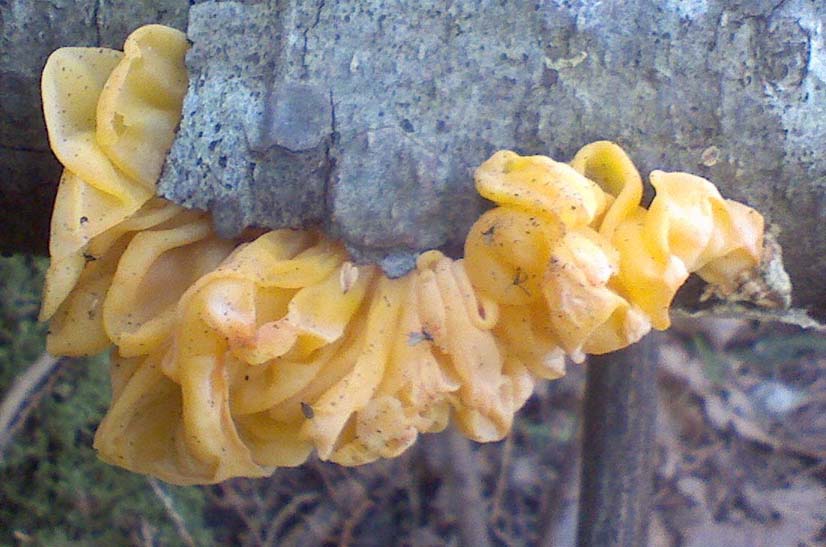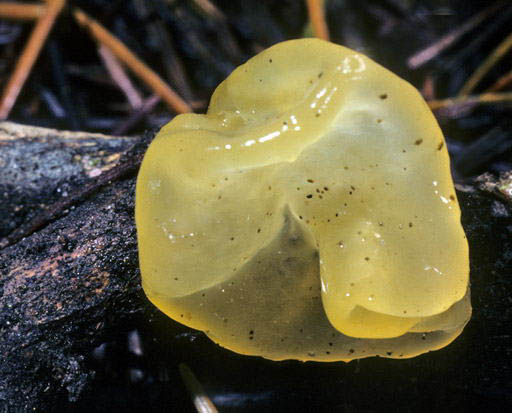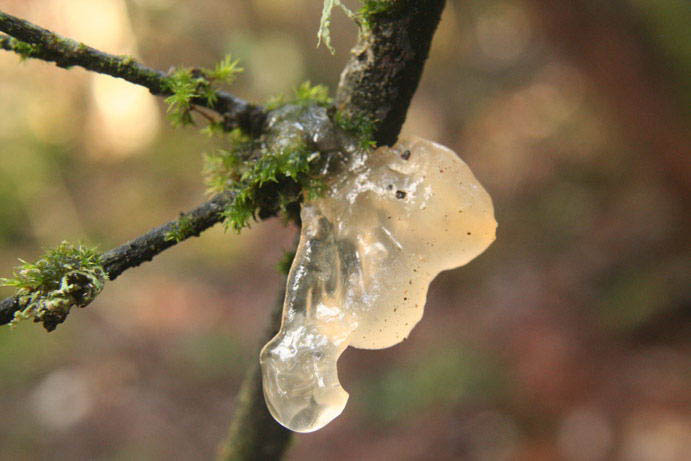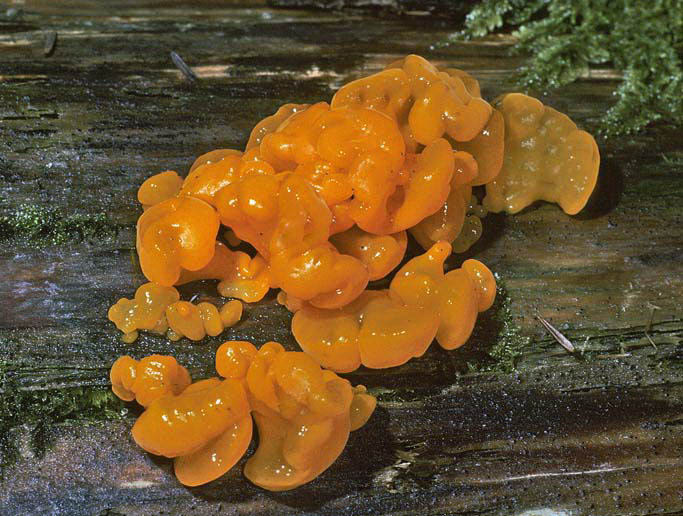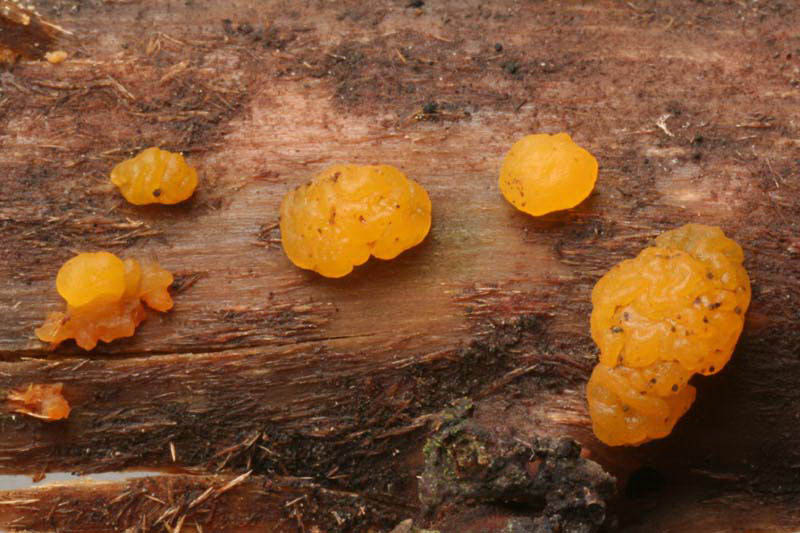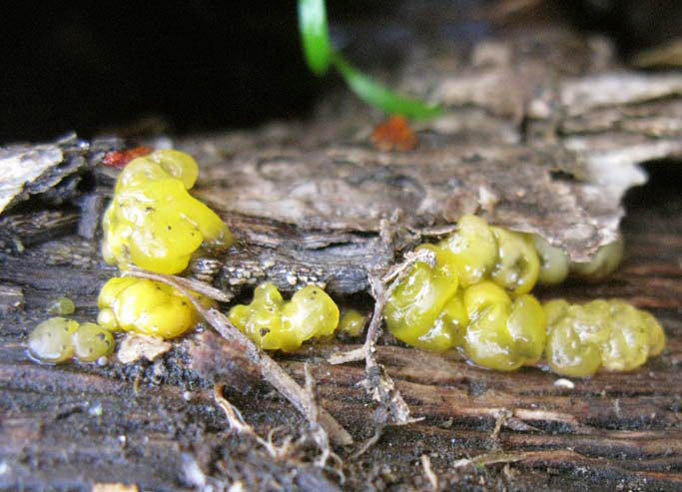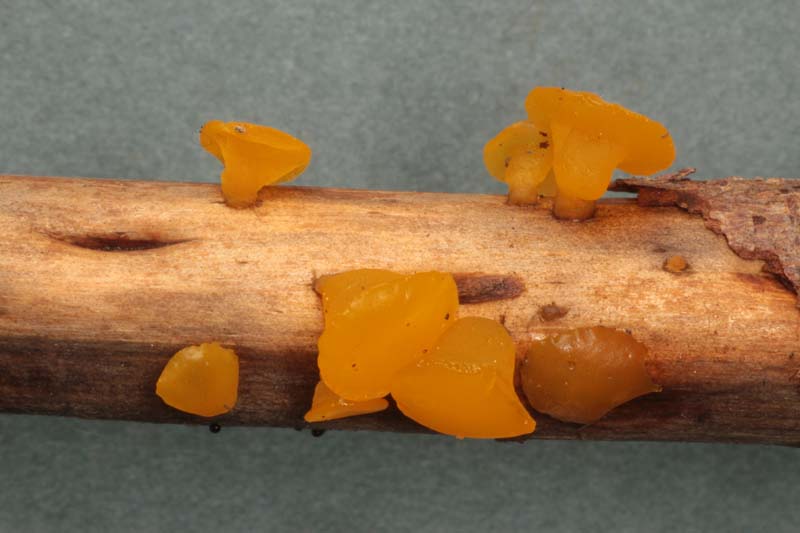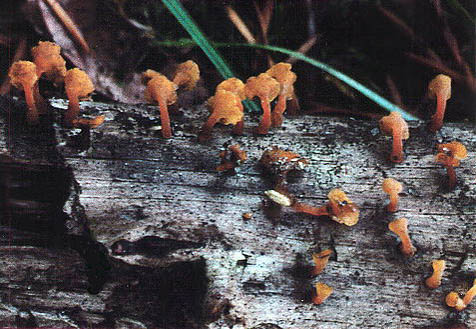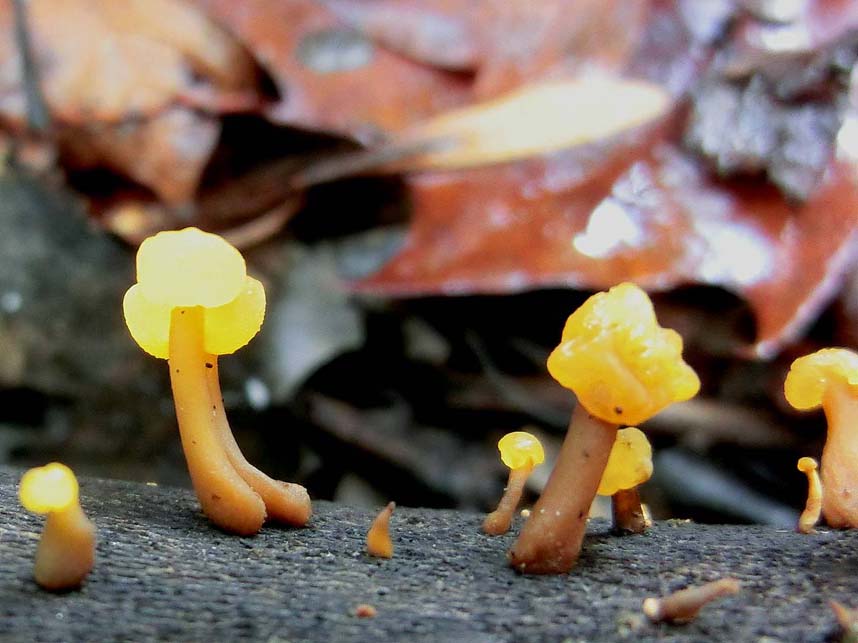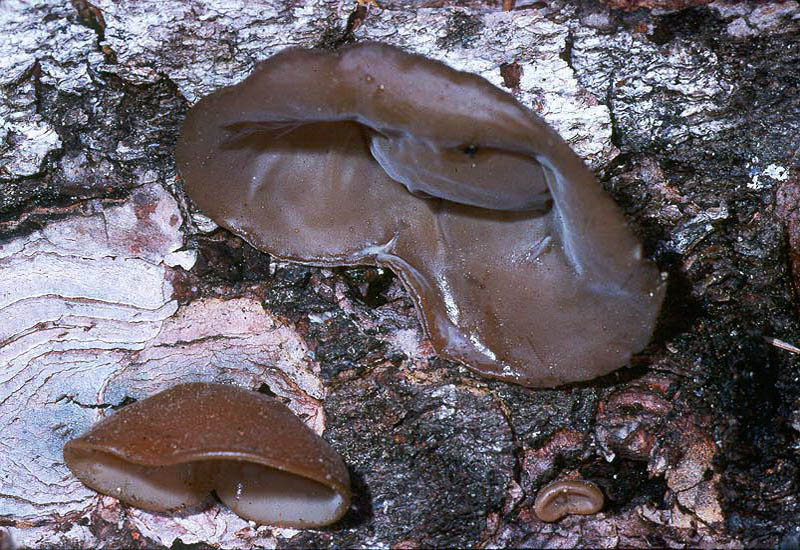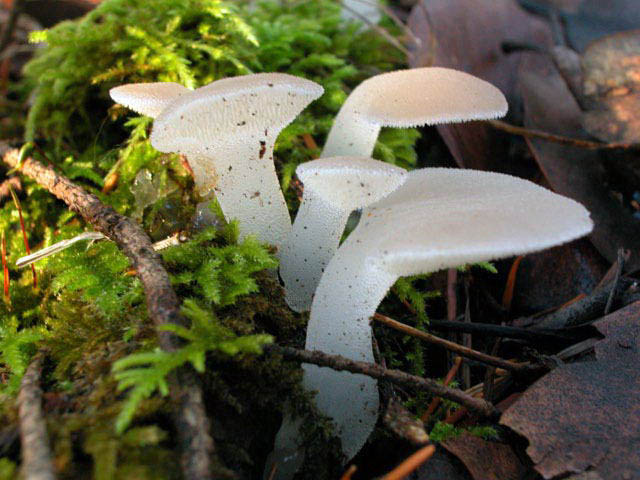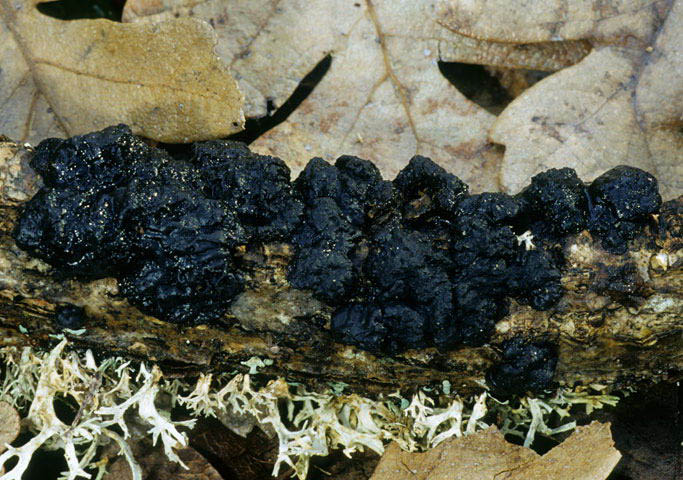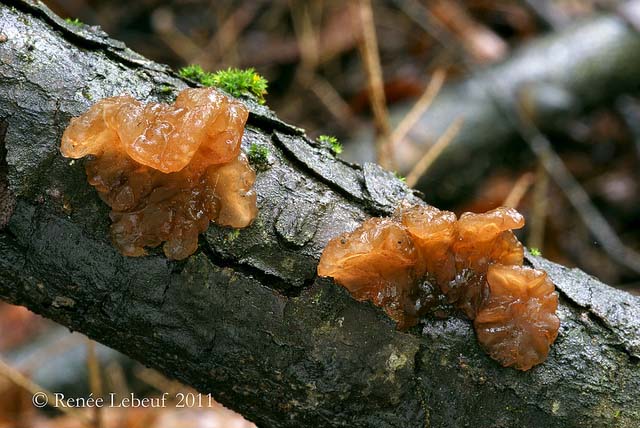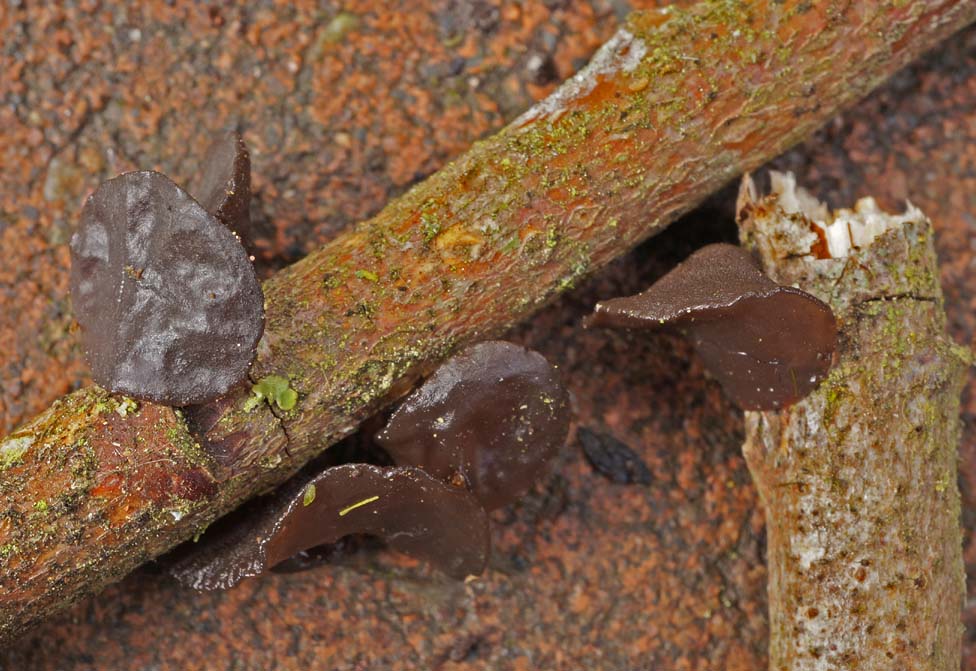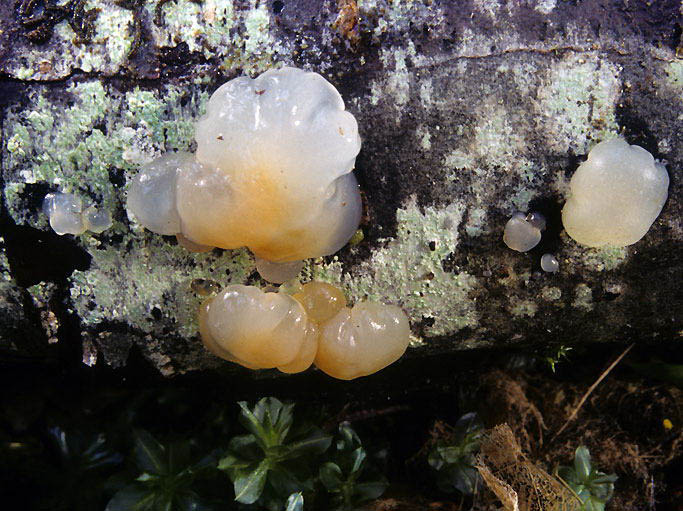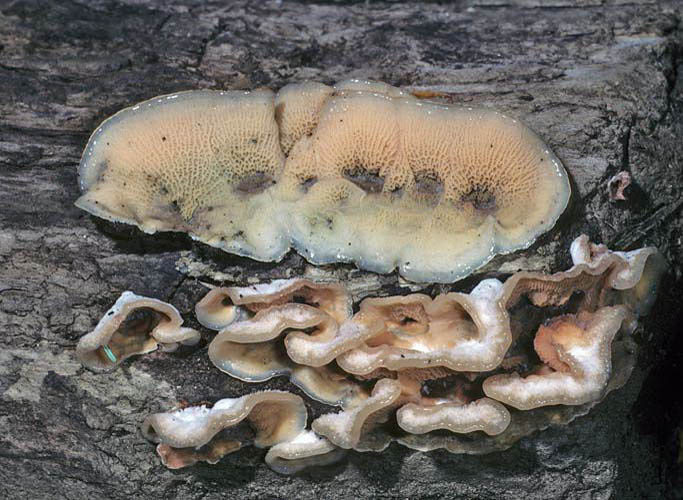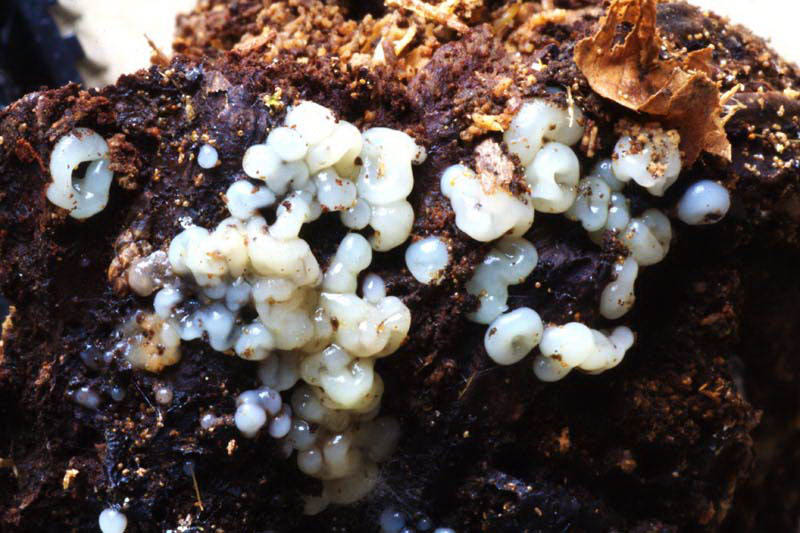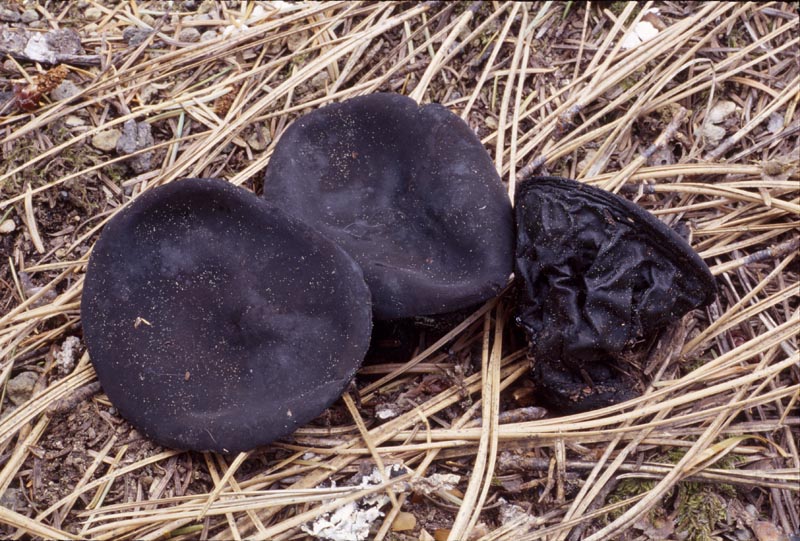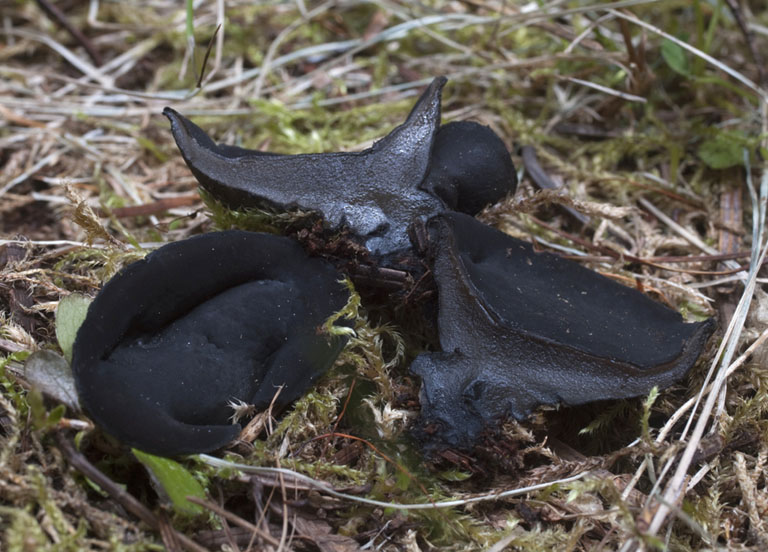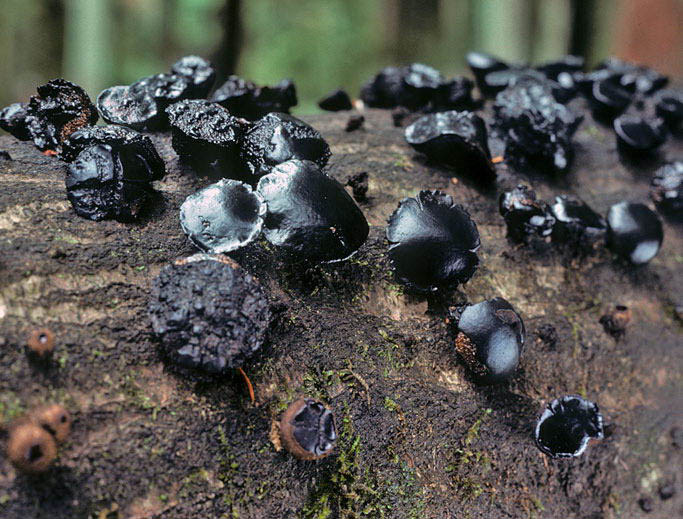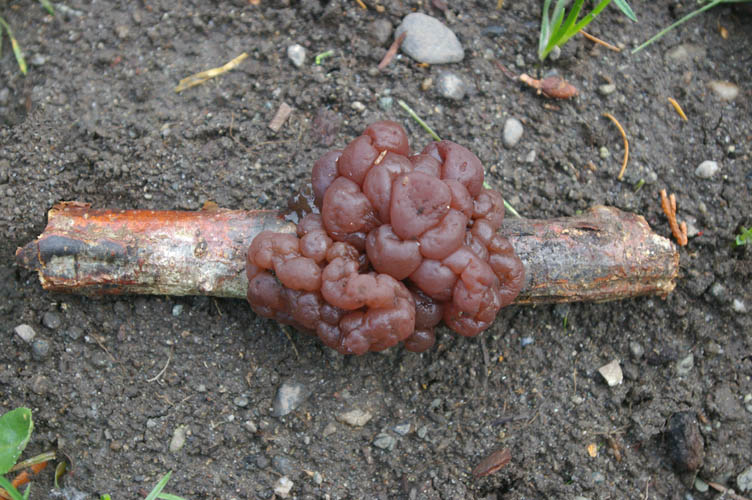Jelly fungi
Jelly fungi represent some of the most primitive
clades of Basidiomycota, two groups of them
in classes by themselves far removed from
the Agaricomycetes class where you find most fruiting bodies. Their simple
gelatinous texture allowed them to survive periods of dry weather and then to
reconstitute themselves during the next rain, before complicated structures like
a cap and gills had evolved. They have unique
microscopic features as well... the Tremellomycetes have basidia that are
divided or "septate" longitudinally, and the Dacrymycetes have bifurcated
basidia like a tuning fork as well as spores that are divided by septa into
sections. These features are shared by some of the most
primitive mushrooms of the Agaricomycetes as well, which also have a jelly-like
consistency. You will find such primitive species in the orders Cantharellales,
Sebacinales and Auriculariales as explained on my
taxonomy page. As is common with the flasks, (among others) some of these jellies are capable of reproducing
asexually as well as sexually.
The Ascomycota phylum has also evolved jelly-like mushrooms,
similar-looking yet not at all related to the other mushrooms on this page. They are not "primitive" but
represent an evolved state that has happened several times. They usually don't
have the same completely jelly texture, but some of them could be confused with Basidiomycota.
Sometimes gelatinous fruiting bodies are only a two dimensional crust of soft
material on wood and will be found on the crusts page.
Species covered on this page are a little more three dimensional. I don't know of any poisonous jellies, but they have not been
well studied. They are mostly tasteless but can add an interesting texture to
trail mix. Any attempt to cook them will probably result in them vanishing into nothing in the
frying pan.
|
Unfortunately there are many similar looking jellies, hard to tell apart, so
I recommend browsing the whole page before making a determination.
|
Tremellomycetes - Literally in a
class by themselves. The yellowish folded species are commonly known as
"Witch's butter". They are parasitic on different crusts
found on wood, most commonly
Stereum,
Aleurodiscus and
Peniophora (all in the Russulales
order) or even on some Ascomycota pimpled "flasks"
in the Sordariomycetes class. You
may or may not be able to see the host crust fruiting on the same log. Believe it or not, the meningitis and
pneumonia causing Cryptococcus fungus is somewhat related to Tremella.
T. mesenterica (lutescens) - fewer folds, and more pale-translucent, on
Peniophora on hardwoods.
T. mesenterella - as T. mesenterica, yellow-brown, usually on willow or dogwood
on Peniophora.
Syzygospora effibulata - related, but not looking
similar, is a waxy film that coats galls that can form on
Gymnopus dryophilus.
Dacrymycetes - also in a class by themselves. Saprophytic on wood, unlike the parastic Tremella.
The large folded species are several cm or more in extent. The smaller
blobs only several mm. Most of the rest of the yellow-orange jellies are found in
this class but most other colours will be found
further down. Dacrymyces species themselves do not usually have a stem, but some
related species do.
D. chrysospermus (palmatus) - conifers, folded, often more
orange than Tremella aurantia, with a white point of attachment.
D. stillatus (deliquescens) - the species most likely to look
like tiny cushions (like
dots) on conifers.
D. ovisporus - the species most likely to look like
little orange brains on
conifer wood. Also see Craterocolla.
D. chrysocomus/variisporus/capitatus - 2-4mm or so variable
orange cushion, cup or top shapes on
conifers, these species are all best separated microscopically.
D. capitatus may be translucent and have the most developed tiny stem. Also see
Heterotextus, below.
D. minor/tortus - sometimes these similar species will have a greenish
tinge.
Other relatives of Dacrymyces, all on wood, somewhat more stemmed:
Heterotextus (Guepiniopsis) alpinus - our
largest top-shape, <1cm, on conifers near snow melt.
Heterotextus luteus - smaller on
conifers, (<8mm), elsewhere, both larger than the Dacrymyces chrysocomus grp.
Ditiola (Femsjonia) peziziformis - top/cup w/white margin and downy surface, <1cm across.
Guepiniopsis buccina - with cap and stem
somewhat fusing,
ribbed underneath. 3-9mm across.
Ditiola radicata - stout stem, more
differentiated than in G. buccina. <5mm across.
Dacryopinax spathularia - flattened head like a
spatula. <1cm across.
Calocera cornea - club shapes, but jelly and not brittle.
On hardwood. <2cm high.
Agaricomycetes - these
jellies are not in a class by themselves, but in the class with most other
Basidiomycota. They share some unique microscopic details with the other jellies,
meaning they have not evolved far from them. The Auriculariales order contains
most of them. Saprophytic.
Auricularia americana ('auricula') - "wood ear", brown, up to
10cm.
Guepinia (Tremiscus/Phlogiotis) helvelloides -
peachy shoehorn,
<10cm on conifers or near them on the ground.
Pseudohydnum 'gelatinosum' grp - teeth underneath the
cap! White, <5cm, on conifer debris.
Pseudohydnum 'gelatinosum' grp - one species has a
larger brown fuzzy cap!
Exidia nigricans/glandulosa
- large, black clumps of jelly that do/do not coalesce into one big mass, >10cm
or more. Compare Bulgaria. E. glandulosa may
not occur here.
Exidia saccharina - red-brown mass, more
amorphous than Tremella foliacea, on conifers. <1cm.
Exidia recisa - red-brown blob on hardwoods.
Also <1cm.
Exidia candida - translucent whitish blobs discolouring
orange-brown, larger than
Tremella globispora, etc., sometimes in expanded masses.
Myxarium atratum (nucleatum) - translucent mass of pustules
covering <10cm, "seeds" embedded in jelly.
See Efibulobasidium.
Craterocolla cerasi -
pinkish orange discs that become brain-like jelly and up to
5cm across, larger and more convoluted than Dacrymyces ovisporus.
On shredded inner Populus bark.
Efibulobasidium albescens - white translucent pustules <3mm
across on herbaceous stems, similar to Myxarium.
These are Sebacinales.
Sebacina epigaea - white pustules converging to
become a flat waxy, jelly crust. In the Sebacinales order. See
also Tremella globispora.
Waxy crusts
are also found in these two orders as well as in the Cantharellales
(the order containing chanterelles!)
Ascomycota - the following jellies
are completely unrelated and belong to the Ascomycota, the first two in the
Pezizomycetes where you find the large cups and the others in the Leotiomycetes class, where
you find some small cups and
earth tongues (just as you might guess from the
general habit of the Pezizomycetes growing on the ground and the Leotiomycetes
growing on wood and being more frequently small).
Urnula padeniana (Sarcosoma mexicanum) - base
filled with black jelly, <10cm, spring and fall
Pseudosarcosoma (Sarcosoma) latahense - smaller,
<5cm, young top surface somewhat purplish-black, thickened base somewhat gelatinous
Bulgaria inquinans - black jelly cushions on hardwood, not
convoluted like Exidia glandulosa and with
a brown scurfy exterior when young and black spores
that stain your hands. Related to some earth tongues. (Leotiales).
Plectania melastoma is similar but not
gelatinous.
Ascotremella faginea - big
brown brain on hardwood. Related to some
small cups. Reports of Neobulgaria pura
here may just be this. (Helotiales)

Chloroscypha (Gelatinodiscus) flavidus - well formed cushions on
a stalk, only on yellow cedar debris, snowmelt species.
Related to some small cups. (Helotiales)
|
